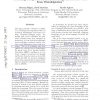ACL
2012
12 years 5 months ago
2012
Polarity classification of words is important for applications such as Opinion Mining and Sentiment Analysis. A number of sentiment word/sense dictionaries have been manually or ...
COLING
2010
13 years 10 months ago
2010
Choosing the right parameters for a word sense disambiguation task is critical to the success of the experiments. We explore this idea for prepositions, an often overlooked word c...
FSKD
2009
Springer
14 years 27 days ago
2009
Springer
Sense Induction is the process of identifying the word sense given its context, often treated as a clustering task. This paper explores the use of spectral cluster method which in...
EMNLP
2009
14 years 28 days ago
2009
Word sense disambiguation is typically phrased as the task of labeling a word in context with the best-fitting sense from a sense inventory such as WordNet. While questions have o...
ACL
2009
14 years 29 days ago
2009
The vast majority of work on word senses has relied on predefined sense inventories and an annotation schema where each word instance is tagged with the best fitting sense. This p...
NAACL
2010
14 years 1 months ago
2010
Semantic role labeling (SRL) not only needs lexical and syntactic information, but also needs word sense information. However, because of the lack of corpus annotated with both wo...
COLING
2002
14 years 2 months ago
2002
We propose a method "Interactive Paraphrasing" which enables users to interactively paraphrase words in a document by their definitions, making use of syntactic annotati...
ACL
1996
14 years 4 months ago
1996
In this paper, we present a new approach for word sense disambiguation (WSD) using an exemplar-based learning algorithm. This approach integrates a diverse set of knowledge source...
ACL
1997
14 years 4 months ago
1997
This paper presents a method to combine a set of unsupervised algorithms that can accurately disambiguate word senses in a large, completely untagged corpus. Although most of the ...
TREC
2003
14 years 4 months ago
2003
We describe an attempt to use word sense as an alternate text representation within an information retrieval system in order to enhance retrieval effectiveness. A performance comp...



